Plant Density and Irrigation Regime Have an Interactive Effect on Common Bean Seed Quality - Juniper publishers
Journal of Trends in Technical and Scientific Research
Abstract
Dry beans (Phaseolus vulgaris L.) are known to
be a significant source of protein, fibre, vitamins, and minerals.
However, poor access to improved quality seeds, water stress and poor
agronomic practices have led to low productivity for smallholder farmers
in South Africa. The study used three certified dry bean seed cultivars
(Mtata, Malelani, and Gadra). A standard germination test, water
activity and seed moisture content were determined each replicated three
times. Pre and post-harvest germination tests were conducted
simultaneously with Germination Velocity Index (GVI) and Mean
Germination Time (MGT). A field trial was designed as a split plot where
rain-fed and irrigation treatments were the main plots within which the
three cultivars were planted at three densities (low, medium and high).
Seed quality of the certified seed lot showed a significant difference
between cultivars. Mtata had an average of 93% germination, while
Malelani and Gadra had 82% each. There were significant differences
between cultivars with respect to germination after harvest. Germination
Velocity Index showed that there was a significant difference
(P<0.05) for the interaction of water regime x density x cultivar.
Across all densities and for all cultivars GVI was higher under
irrigation compared with dry land conditions. It is concluded that water
availability and plant density have interactive effects on dry bean
seed quality.
Keywords: Germination; Plant density; Seed quality; Water regime
Abbreviations: GVI: Germination Velocity Index; MGT: Mean Germination Time
Introduction
Common beans are an important source of essential vitamins, minerals; and most importantly, proteins [1].
Deficiency in humans has led to protein-deficient diseases such as
muscle wasting, swelling due to water retention, low blood pressure and
heart rate, anaemia and liver problems [2]. Dry beans (Phaseolus vulgaris) are known to be a significant source of protein, fibre, vitamins, and minerals [3].
However, access to improved agricultural resources such as quality
seeds and water stress has been observed to be a limiting factor to
productivity in developing countries [4].
Smallholder farmers have been observed to use retained dry bean seed
harvested from previous seasons as they cannot afford to purchase
improved seed varieties [5].
Due to the self-pollinating nature of legumes, inbreeding depression
often leads to decreased quality and vigour of subsequent seed [6]. In addition, water stress conditions in which the maternal plant is exposed affects seed quality and vigour [7].
Therefore, the use of retained seed coupled with areas of limited water
availability increases the risk of low and non-uniform germination and
poor seedling emergence leading to significant yield losses [7].
The use of retained dry bean seed combined with
limited resources and knowledge for agricultural production will
continue to dominate many smallholder farmers. Water stress on
developing maternal plant has been observed to affect seed mass and
endosperm biochemical constituents; thus affecting seed quality (soybean
and faba beans) [8], and vigour [9]. Ahmadi and Bahrani [10]
observed that water stress on sunflower under water limited conditions
resulted in poor seed set, small and shrivelled seed; this was strongly
correlated to subsequent reduction in seed quality. On the contrary,
other authors have reported no significant effect on seed quality in
response to production environment [11-13].
Opportunities for improving dry bean seed quality exist in the use of
good water management strategies on the maternal plant. Such strategies
include the use of appropriate planting dates, plant densities and
adaptable varieties. Planting dry bean at an appropriate planting date
resulted in increased crop growth period, and pod number, number of
grains per pod, 100-grain weight, and finally grain yield [14]; this also translated to high progeny seed quality. A study done by Joshi & Rahevar [15]
showed that optimum plant spacing improved water use efficiency and
consequently improved seed quality. Ghassemi-Golezani &
Mazloomi-Oskooyi [6] reported that the use of drought tolerant varieties increased seed quality of dry bean.
Although the use of optimum agronomic management
practices can be used to improve subsequent dry bean seed quality under
water-limited conditions, there is gap in information to quantify the
possible gains. In-order to ensure that smallholder farmers sustainably
produce dry beans, there is a need to assess and quantify the effects of
different agronomic practices on subsequent seed quality. Therefore,
the aim of this study was to determine the effect of planting date,
plant density and water availability on subsequent seed quality of
different dry bean varieties. The specific objectives were to determine
initial, and subsequent seed quality for three bean varieties grown
under varying agronomic practices.
Materials and methods
Plant material
Three dry bean varieties, namely, Mtata, Malelani,
and Gadra, were sourced from McDonald's Seeds (Pty) Ltd in
Pietermaritzburg KwaZulu-Natal. Umtata is a determinate variety reported
to be suitable for growing under conditions prevalent around
Pietermaritzburg. Malelani is a fine bean for the pre-pack market bred
to suit South African conditions. Malelani yields a very attractive
straight bean, with a green colour, and with an excellent uniformity.
The field holding ability of Malelani is good while seed development is
slow. It has good disease resistance and vigorous growth. Gadra is well
adapted to the lowveld and KwaZulu-Natal production areas and well
adapted for late planting when compared with other varieties. It is
early maturing, excellent disease resistance, upright, bush growth habit
and large seed size.
Seed quality test
A series of seed quality tests were conducted for the
original purchased seeds and the progeny at the University of
KwaZulu-Natal's seed technology laboratory. For the progeny, seed
quality tests also included water activity and seed moisture content.
Water activity and seed moisture content
The Decagon Model AquaLab Series 3 water activity
meter (Decagon Devices, USA) was used to measure seed water activity.
Three replications were done for each treatment. A grain moisture meter
(Model am-5000, China) was used to measure seed moisture content of
harvested seeds using settings (P8) for dry bean. Three replications
were also done for each treatment.
Standard germination test
Seed germination capacity was determined using the
standard germination test under laboratory conditions.Briefly, three
replicates consisting of 25 seeds of each variety (Gadra, Mtata and
Malelani) were germinated between doublelayered moistened brown paper
towels (ISTA, 2011). The paper towels were rolled and tied at either end
with rubber bands before being placed in zip-lock bags to prevent
moisture loss. The zip-lock bags were then placed in a germination
chamber set at 25°C (Germination cabinets, Model PL2, England) were they
were kept for 8 days. Seed germination was observed daily, and
germination was defined as radicle protrusion of 2 mm (ISTA, 2011).
Germination velocity index
Seed vigour was measured using the germination
velocity index (GVI) (germination speed) and calculated based on
Maguire's (1962) formula:

where:
GVI = Germination Velocity Index,
gi, G2...Gn = number of germinated seeds in first, second... last count, and
NI, N 2... Nn = number of sowing days at the first, second. last count.
Mean germination time
Mean germination time (MGT) was calculated according to Ellis and Roberts (1981) formula:

where;
n = number of seeds which were germinated per day D, and
D = number of days counted from the beginning of germination.
Field trials
A set of trials were conducted to determine the
effect of planting date, plant density and water availability on dry
bean growth, development and yield over two seasons (early and late
season).
Description of experimental site and management
Field trials were conducted at the University of
KwaZulu- Natal's Ukulinga Research Farm in Pietermaritzburg (29° 37' S;
30° 16' E; 775 m a. s. l.). The planting dates for the early and late
season were 12 January and 03 May 2016, respectively. The trials were
harvested on 12 April and 13 September 2016, respectively.
Prior to planting, soil samples were taken from the
field for soil fertility analyses. The sampling followed standard
sampling procedure of taking three samples randomly in the field from
upper, middle, and lower part of the field to represent the whole field.
Soil samples were analysed for soil fertility at Cedara (29° 31' 59.99”
S and Longitude: 30° 16' 60.00” E). The same procedure was repeated
again after harvesting to determine soil fertility levels at the end of
the season.
Experimental design
The experimental design was a split-plot laid out in
randomised complete blocks and replicated three times. There were three
factors, namely, (i) varieties (Mtata, Malelani and Gadra), (ii) plant
densities (high, medium and low), and (iii) water regime (rain-fed and
irrigated). The field was 30 x 20 m. The three varieties were as
described in Section 3.1. High plant density involved planting seeds at
0.5 x 0.2 m, low medium density at 0.5 x 0.3 m and high density at 0.5 x
0.5 m. The irrigated water regime included watering the crops at 30 mm
per week for the duration of the trials. Rain-fed trials were
established with irrigation to allow for maximum plant stand thereafter,
irrigation was withdrawn after crop establishment.
Prior to land preparation, soil samples were taken to
Cedara for analysis and fertility recommendations. Land preparation was
done by disking and rotovating to achieve a fine tilth. The field
trials were sprayed using Mancozeb (Dithane M45) at 45 g /15 L for
cutworm. Weeding was done routinely by hand hoeing.
Statistical analysis
Data collected were subjected to analyses of variance
(ANOVA) using GenStat® Version 18 (VSN International, United Kingdom)
at the 5% probability level. Duncan's test on GenStat® at the
probability level of 5% was used to compare means.
Results and Discussion
There were significant differences (P=0.027) observed
for final germination for three dry bean varieties. Although these
differences were nominal, the trend observed the for final germination
was Mtata (91.5%) > Gadra (84.5%) > Malelani (83.5%) (Figure 1).

There were significant differences (P=0.027) observed
for Germination Velocity Index (GVI) for three dry bean varieties. The
trend for germination velocity index was Mtata (24) > Gadra (23.1)
> Malelani (21.9) (Figure 2).
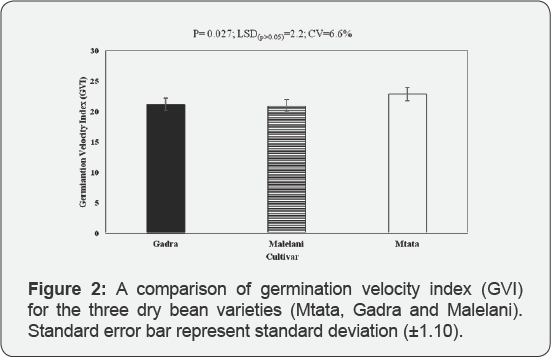
There was a significant difference (P<0.05) for
germination percentage with regards to the interactions of water regime x
plant density x variety x time interaction. Overall, across the water
regimes and plant densities (Figure 3A- F),
Gadra had the lowest germination (28.30%) and Malelani the highest
germination (98.80%). Similarly, under the two water regimes irrigated (Figure 3A- C) and rain-fed (Figure 3D-F), Malelani had the highest germination (98.80%) and Gadra the lowest germination percentage (31.70%). Medium density (Figure 3B & E) had the highest germination % (93.20%) while high density (Figure 3C & F)
had the lowest germination percentage (74.30%). With respect to variety
Mtata and Malelani showed the highest seed germination (88.50%) while
Gadra showed the lowest germination (78.70%).
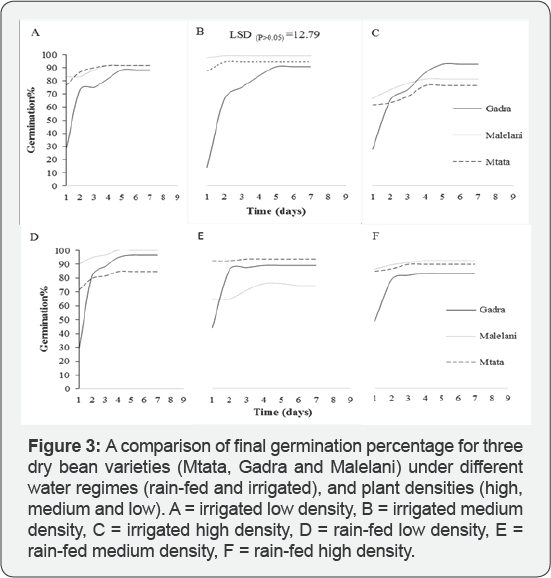
Germination Velocity Index (GVI) showed that there
was a significant difference (P<0.05) for the interaction of water
regime x plant density x variety (Figure 4). Overall, the mean GVI for the dry bean varieties were 2.57, 2.47 and 2.57 for Malelani, Mtata and Gadra respectively (Figure 3 & 4).
Germination Velocity Index showed that seeds harvested from maternal
plants grown under irrigated conditions had higher GVI compared to under
rain-fed conditions. Medium planting density had the highest GVI (3.56)
relative to low planting density (2.51) and high planting density
(2.19).
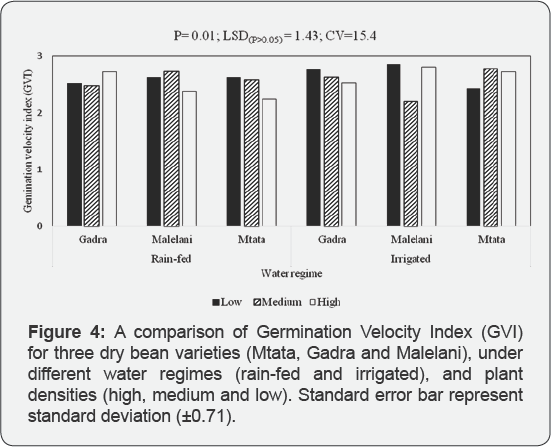
There were significant differences (P=0.01) observed
for the Mean Germination Time (MGT) for the interaction of water regime x
plant density x variety. Gadra had the lowest MGT respectively to Mtata
and Malelani, Malelani (0.44 days) > Mtata (0.42 days) > Gadra
(0.36 days). Under irrigation, MGT was lower (0.35 days) relative to
when dry beans were grown under rain-fed conditions (0.39 days). For
three plant densities MGT was observed to be higher under high density
(high density (0.42 days) >, medium density (0.4 days) >, and low
density (0.38 days). Across all treatment combinations, Malelani under
irrigation, and medium density had the highest MGT, and the lowest MGT
was seen for Malelani under low density under irrigated conditions (Figure 5).
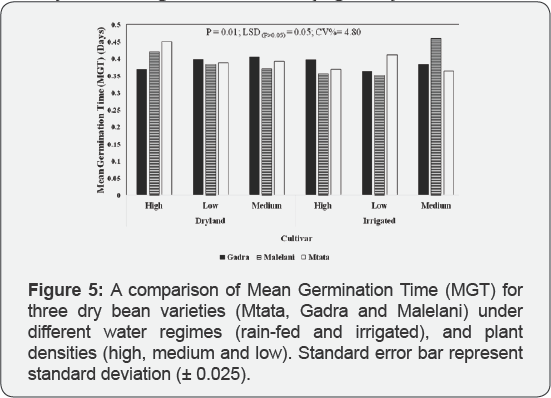
An interaction of plant density and cultivar had
significant effect (P=0.041) on dry bean seed moisture content. Planted
under the low-density treatment had the lowest seed moisture content
(9.90%) relative to high (10.10%) and medium (10.20%). There was no
significant difference (P > 0.05) between the three dry bean
varieties Gadra (10.00%), Malelani (10.10%), and Mtata (10.00%). The
treatment combination of variety (Malelani) and medium plant density had
the highest seed moisture content compared to the low and high plant
densities. Overall Mtata variety under high plant density showed highest
grain moisture (Figure 6).
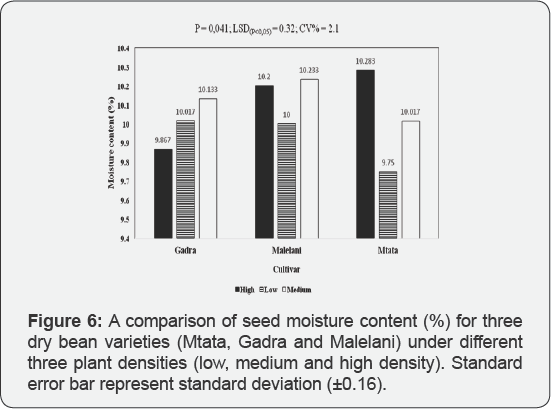
There were highly significant differences (P=0.001)
observed for the seed water activity for the interaction of water regime
x variety (Appendix G). Seeds harvested from maternal plants grown
under irrigated conditions had the lowest water activity (0.52) when
compared with rain fed field (0.54) (Figure 7).
The treatment combination of variety x water regime, seeds of Mtata
harvested under rain-fed conditions had the highest water activity
relative to irrigated field. While Gadra under irrigated conditions had
the lowest water activity (Figure 7).
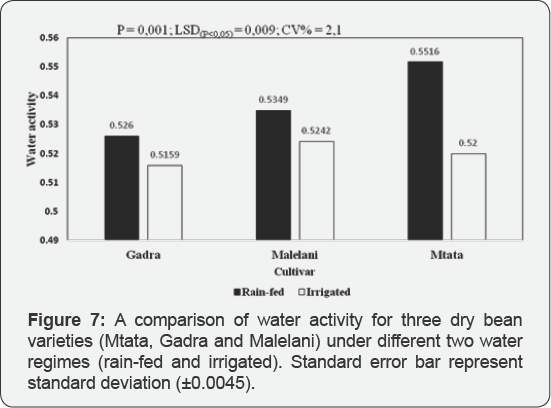
Significant differences (P<0.05) were observed
under pre-planting and post planting germination results among the dry
bean seeds varieties. This confirms that studied dry bean seed varieties
had an influence on the subsequent seed quality. This could because of
the genetic differences amongst the dry bean seed varieties [16].
Initially, Mtata variety had the highest percentage seed germination
but Malelani had the highest percentage germination post-planting. This
shows that subsequent dry bean seed quality was affected environmental
factors due to maternal plant [17].
Seeds produced under rain-fed conditions had high
germination percentage over a short period. Germination velocity index
was higher under rain-fed conditions when compared with under irrigated
conditions. Mean germination time was lower under rain-fed conditions
meaning that the subsequent seeds were able to germinate faster than
those from the irrigated trial. This could suggest that limited water
availability subsequent seed quality could actually be enhanced [10].
Under water limited conditions, adaptable seed will aim to germinate
and establish quickly to take advantage of available water [6].
It could be that the reduction in pod number and average seed number
per pod under water stress conditions helps maintain seed integrity with
regards to seed quality [13].
It was observed also that under the lower plant densities the seed
quality indices were low. This implies that planting dry bean under low
plant density has no favourable gain on seed quality but only on grain
yield.
Conclusion
In the present study, subsequent dry bean seed
quality varied among different management practices. Mtata, Malelani and
Gadra dry bean varieties varied in their responses to the varied
agronomic conditions. Seed germination, GVI, and MGT were favourable
under rain-fed conditions. This implies that dry bean seed can be grown
under rainfed conditions for the purposes of seed without adverse
effects on the quality (germination and vigour) of the seed. The study
also highlights the importance of the correct combination of management
practices in which the maternal plants are exposed for good quality
seeds.
Acknowledgement
The Water Research Commission of South Africa is
acknowledged for funding this research through WRC Project No. K5
/2274//4 "Determining water use of indigenous grain and legume food
crops”. The Agricultural Research Council of South Africa is also
acknowledged.
To Know More About Trends in Technical and ScientificResearch click on: https://juniperpublishers.com/ttsr/index.php
To Know More About Open Access Journals Please click on:




Comments
Post a Comment